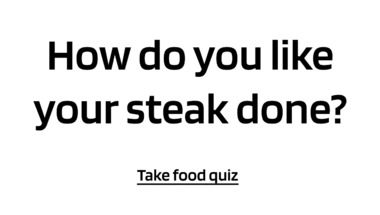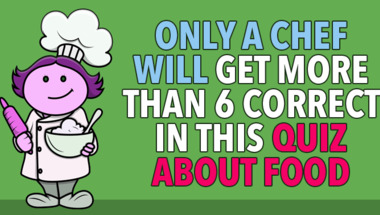
10 questions about cooking
Difficulty : Medium Get 6/10 correct to pass the quiz
Question 1 of 10
Frying small bits of meat and vegetables over very high heat with continual stirring produces what?
Question 2 of 10
What is the small stick used to hold foods together while grilling called?
Advertisement
Question 3 of 10
In grilling, food is cooked using what kind of heat?
Question 4 of 10
What would a cook use a "mandoline" for?
Question 5 of 10
Which of the following items is not often used as a thickening agent?
Question 6 of 10
How do Italian biscotti get their characteristic dry quality?
Question 7 of 10
Which event would be disastrous when making a meringue?
Advertisement
Question 8 of 10
What common dairy product is used to give custard pies their consistency?
Question 9 of 10
What sauce is made by adding white wine, vinegar and tarragon to hollandaise sauce?
Question 10 of 10
What is the Mexican dish made of a tortilla filled with melted cheese and folded in half called?
Advertisement

MORE QUIZZES
Quiz : We give you the movie
How many correct answers will you get?
How many correct answers will you get?

High IQ trivia quiz
Question 9 and 10 will be quite the challenge
Question 9 and 10 will be quite the challenge

Trivia challenge for experts
Do you have it in you?
Do you have it in you?

History Quiz
10 mixed questions
10 mixed questions

Quiz : Cars of the past
How many correct answers will you get?
How many correct answers will you get?

Trivia Quiz : The Average Jo
10 Hard Questions!
10 Hard Questions!

1960s Song Quiz
10 songs to guess
10 songs to guess

Hard Geography Quiz
10 questions to test your knowledge
10 questions to test your knowledge

Quiz about old nostalgic chi
How many of them will you remember?
How many of them will you remember?

Fun trivia quiz
10 questions for you
10 questions for you

Trivia Quiz for everyone on
Trivia quiz for experts
Trivia quiz for experts

Mixed Knowledge Quiz
Let's see how smart you really are!
Let's see how smart you really are!

Advertisement
10 general trivia questions
How many correct will you get?
How many correct will you get?

Movie Quiz (10 questions)
How well do you know these movies?
How well do you know these movies?

Geography Quiz (Super Hard)
Can you score 5 or higher?
Can you score 5 or higher?

Genius Trivia Test
8/10 will only happen if youre a genius!
8/10 will only happen if youre a genius!

Quiz : Music in the 1960s
Did you live in this awesome decade?
Did you live in this awesome decade?

Quiz : Old sayings
How many correct will you get?
How many correct will you get?

Einstein Trivia Quiz
10 Impossible Questions
10 Impossible Questions

Movie Quiz
10 questions
10 questions

A quiz about food & cooking
10 Quite Difficult Questions
10 Quite Difficult Questions

Mixed Trivia Questions
10 questions to test your knowledge
10 questions to test your knowledge

Do you know Italian words?
10 questions to test your knowledge
10 questions to test your knowledge

Mixed knowledge questions
How many correct answers will you get?
How many correct answers will you get?

Advertisement
History 10 question quiz
Trivia fun
Trivia fun

Trivia Quiz for everybody
Post your score in the comments!
Post your score in the comments!

History Quiz
What do you remember?
What do you remember?

General Trivia IQ challenge
How smart are you really?
How smart are you really?

Mixed knowledge trivia quiz
10 questions to answer
10 questions to answer

1964 song quiz
How many of them will you answer correctly?
How many of them will you answer correctly?

Music Quiz
How good is your memory
How good is your memory

Food & Cooking Quiz
How many correct will you get?
How many correct will you get?

Quite hard trivia quiz
10 thrilling questions
10 thrilling questions

Quiz : 10 Questions About Mu
Let's test your trivia skills!
Let's test your trivia skills!

Science Quiz
How nerdy are you?
How nerdy are you?

History Quiz
10 questions to test your knowledge
10 questions to test your knowledge

Advertisement
1950s Music Quiz
10 mixed up questions
10 mixed up questions

General Knowledge Quiz (10 q
Are you up for a quiz?
Are you up for a quiz?

General Trivia Challenge
10 random questions
10 random questions

A trivia quiz for knowledge
That last questions will make you stumble
That last questions will make you stumble

Mixed history questions
That last questions will make you stumble
That last questions will make you stumble

General Knowledge Quiz (10 q
Are you up for a quiz?
Are you up for a quiz?

Mixed Knowledge Quiz
10 mixed questions
10 mixed questions

Trivia Quiz : Can you score
Expert questions for developed minds
Expert questions for developed minds

General Knowledge Quiz (10 q
Are you up for a quiz?
Are you up for a quiz?

Mixed knowledge questions
10 questions in mixed categories
10 questions in mixed categories

1960s Song Quiz
10 mixed questions
10 mixed questions

10 trivia questions for smar
How high will you score?
How high will you score?

Advertisement
Food Quiz
10 mixed questions
10 mixed questions

1970s Song Quiz
How many correct answers will you get?
How many correct answers will you get?

The big Rik Mayall quiz
How well did you know the man?
How well did you know the man?

Quiz about _ C _ C _ _ _ _
Do you have the brains? :)
Do you have the brains? :)

10 General Knowledge Questio
Are you up for the challenge?
Are you up for the challenge?

Quiz on History
10 questions about history
10 questions about history

Expert Music Quiz
Very difficult mixed music questions
Very difficult mixed music questions

History trivia quiz
10 questions to answer
10 questions to answer

Crazy hard trivia quiz
10 questions
10 questions

Trivia challenge
10 questions to battle
10 questions to battle

10 questions of general triv
Quiz time is here
Quiz time is here

General Trivia Quiz
10 questions to test your knowledge
10 questions to test your knowledge

Advertisement
Trivia Quiz
10 questions to test your knowledge
10 questions to test your knowledge

Do you like quizzes?
Try this fun quiz
Try this fun quiz

10 General Knowledge Questio
Let's see how smart you really are!
Let's see how smart you really are!

Crazy hard trivia quiz
Are you the genius for this quiz?
Are you the genius for this quiz?

1960s Song Quiz
Let's see how smart you really are!
Let's see how smart you really are!

Impossible history questions
Do you have it in you?
Do you have it in you?

Expert Level Trivia Quiz
10 Quite Difficult Questions
10 Quite Difficult Questions

Movie Trivia Quiz
10 fun questions
10 fun questions

History Quiz
How many correct will you get?
How many correct will you get?

Mixed knowledge questions
That last questions will make you stumble
That last questions will make you stumble

Quiz about famous people
10 Impossible Questions
10 Impossible Questions

Mixed trivia quiz for smart
10 mixed questions
10 mixed questions

Advertisement
General Trivia Quiz
10 mixed up questions
10 mixed up questions

Mixed trivia quiz
10 general knowledge questions
10 general knowledge questions

10 Difficult Music Questions
Let's test your trivia skills!
Let's test your trivia skills!

Movie Quiz
10 mixed questions
10 mixed questions

Trivia Quiz. Are you ready?
10 mixed up questions
10 mixed up questions

General Knowledge Quiz
10 mixed questions to challenge your knowledg..
10 mixed questions to challenge your knowledg..

10 mixed genre questions
A quiz for the smartest of the smartest
A quiz for the smartest of the smartest

1970s Song Quiz
10 songs to guess
10 songs to guess

Fun geography quiz
10 mixed questions
10 mixed questions

General trivia quiz
10 mixed questions
10 mixed questions

Amusing trivia quiz
10 fun and challenging questions
10 fun and challenging questions

Trivia quiz for our top foll
You score too many 10 out of 10s!!
You score too many 10 out of 10s!!

Advertisement
Mixed Trivia Questions
How many correct answers will you get?
How many correct answers will you get?

10 General Knowledge Questio
How many correct answers will you get?
How many correct answers will you get?

1960s Song Quiz
How many correct will you get?
How many correct will you get?

10 expert trivia questions
How smart are you really?
How smart are you really?

Nostalgia Trivia Quiz
10 questions to test your knowledge
10 questions to test your knowledge

Mixed Knowledge Quiz
How many of them will you answer correctly?
How many of them will you answer correctly?

General Knowledge Quiz
10 mixed questions
10 mixed questions

HARD quiz about song lyrics
Let me know your low score in the comments :)
Let me know your low score in the comments :)

General trivia quiz
How smart are you?
How smart are you?

World History Quiz
Did you pay attention in school?
Did you pay attention in school?

1960s Hits Lyrics Quiz
10 Songs. Can you guess them all?
10 Songs. Can you guess them all?

Food/Cooking Quiz
10 tasty questions
10 tasty questions

Advertisement
Trivia quiz. Can you outsmar
10 smart questions for you
10 smart questions for you

World History Quiz
Let's see how smart you really are!
Let's see how smart you really are!

Mixed Knowledge Quiz
10 mixed questions
10 mixed questions

History trivia for the smart
How deep can you go?
How deep can you go?

Hard food & cooking
How many of these food questions can you answ..
How many of these food questions can you answ..

Quiz : Words in foreign lang
10 words. 5 you might know, 5 you will fail.
10 words. 5 you might know, 5 you will fail.

Trivia Quiz
10 mixed questions
10 mixed questions

General Trivia Quiz
10 mixed questions for you to have fun with
10 mixed questions for you to have fun with

Trivia Quiz : Can you score
10 mixed general trivia questions
10 mixed general trivia questions

Trivia Quiz - Smarter than a
10 questions than even a monkey can answer
10 questions than even a monkey can answer

Quiz about cars
How many correct will you get?
How many correct will you get?

Trivia Quiz : General Knowle
10 quite impossible questions
10 quite impossible questions

Advertisement
Music Quiz for everyone
Can you tune in on these 10 difficult questio..
Can you tune in on these 10 difficult questio..

10 General Knowledge Questio
10 trivia questions waiting here
10 trivia questions waiting here

General trivia quiz
10 questions to test your knowledge
10 questions to test your knowledge

Trivia Quiz
10 questions
10 questions

10 questions that will test
Take the quiz and get your result
Take the quiz and get your result

10 mixed general trivia ques
Fun quiz. Play now
Fun quiz. Play now

10 General Knowledge Questio
How many of them will you answer correctly?
How many of them will you answer correctly?

Food Quiz For Home Cooks
10 mixed questions
10 mixed questions

General Knowledge Quiz (10 q
10 mixed questions
10 mixed questions

Movie Quiz
10 movie questions
10 movie questions

Find the one that does not f
It's not always as easy as it looks!
It's not always as easy as it looks!

Trivia Quiz for geniuses
10 fun and challenging questions
10 fun and challenging questions

Advertisement